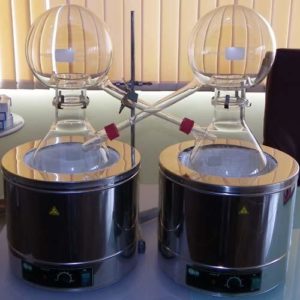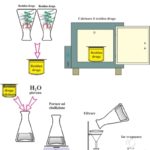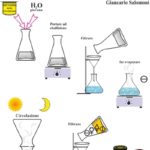QSPC (Canonical Spagyric Quintessence of Paracelsus)
 The true Canonical Spagyric Quintessence of Paracelsus (QSPC) embodies the three alchemical philosophical principles, namely Mercury, Sulfur and Salt.
The true Canonical Spagyric Quintessence of Paracelsus (QSPC) embodies the three alchemical philosophical principles, namely Mercury, Sulfur and Salt.
Later we will see the correspondences of these three principles in the plant realm, but first I would like to point out that the true Paracelsus Canonical Spagyric Quintessence, whose symbol is the five-pointed star, not to be confused with the six-pointed star depicting the seal of Solomon, can be obtained in all three realms (plant, mineral and animal).
In this little excursus on the Spagyric Quintessence of Paracelsus Canonica I will only tell you about the one related to the plant kingdom, trying, as best as I can, to explain it.
Let us now see the modus operandi for obtaining a Spagyric Quintessence of Paracelsus Canonical.
The fresh plant is taken and in a steam current the essential oil that is the plant’s philosophical Sulfur is distilled from it, such distillation can also be done without sophisticated equipment in the following way:
you take a long-necked, frosted-mouthed Pyrex flask, put 1/4 of its volume of ground fresh plant inside it, and then bring, by adding distilled water, the volume to 3/4 of the flask’s capacity. This is done by placing over the long-necked flask the relevant moro head or capital, and placing a heat source under the flask begins the distillation. When the water begins to come out of the nose of the dark-head it will carry with it some of the plant’s essential oil; when almost all the water is distilled, the heat source under the flask is turned off; now in the distillate collection jar we will have water and essential oil. The essential oil, having a lower specific gravity than water, will remain afloat and therefore it will be very easy for you, with a simple pipette, to retrieve it (a little advice I can give you is to pour the contents of the collection jar into a tall and narrow graduated cylinder, as the distilled essential oil will not be much and therefore the smaller the diameter of the cylinder the thicker the essential oil will be making it easier to extract it with the pipette). At this point you have obtained the first principle (Philosophical Sulfur) of the three you need to make Paracelsus Canonical Spagyric Quintessence.
Let us now see how to derive the second principle, namely philosophical Mercury, which, in the plant kingdom corresponds to ethyl alcohol.
This alcohol is made from the plant itself. After the essential oil or Philosophical Sulfur has been extracted, the residue of the plant will have remained in the long-necked Pyrex flask; it is from this residue that the alcohol, which can be obtained by fermenting the plant itself, is to be made. This fermentation will produce an alcoholic solution that, distilled and rectified, will reach 95 volumetric degrees. Reading here it all sounds easy, and indeed it would be, except that to make a Paracelsus Canonical Spagyric Quintessence one should never add anything extraneous to the plant. Then the practitioner will need to understand how to produce and extract the alcohol, or Philosophical Mercury, from the plant itself.
It is necessary to know that in every plant there is an abundance of a substance that is broken down into “sugars,” and that alcohol can be made from sugar. This clue, or if you better believe this hint, is not as small as you might think, reread this last passage and think about it; once you find the key you will have in your possession the canonical alcohol of the plant, or rather, the philosophical Mercury of the plant itself, which is the second of the three principles you are interested in. In a Spagyric Quintessence of Paracelsus Canonical all the alcohol contained in it is alcohol obtained from the fermentation of the plant from which the Philosophical Sulfur was obtained. Let us now see how the third principle, specifically Salt, is obtained.
Once the alcohol has been obtained, there will be plant debris left at the bottom of the pot, which should be burned to ashes, which should be placed in a Pyrex jar by pouring distilled water over it at a ratio of 1 in 10 by volume, that is, 9 parts distilled water for every part ash. You now place the jar over a heat source and bring it to a boil, at which point you pour it into a pyrex glass funnel with filter paper (pure cellulose filter) and under it another pyrex jar to collect the filtered boiling liquid. When all the solution has passed into the jar below the funnel, place the latter over a heat source and allow the solution to evaporate until salts have formed at the bottom of the jar, which should be placed in a crucible and the whole thing in a muffle furnace for 24-48 hours at a temperature of about 500-600°C. After that time has elapsed, the salts are extracted from the muffle and the leaching and calcination of the salts is repeated three times; at the end of these operations, very white and purified salts are obtained, representing the third principle (Philosophical Salt). Having obtained the three principles, it is necessary to “bring them together.”
 For this purpose you need two circulators, for example, two pelicans, into which you will pour alcohol (Philosophical Mercury) in the first and essential oil (Philosophical Sulfur) in the second; if you have only one circulator you need to divide the process first with alcohol and then with essential oil. The salts obtained above (Philosophical Salt) should be divided into two parts: one part inside the circulator containing Philosophical Mercury and the other inside the one containing Philosophical Sulfur. The two circulators are sealed, placed over a heat source and left to circulate for a philosophical month. The heat source should be as constant as possible and the circulating temperature should not be high, the fire should be of the first degree which corresponds to the most famous “heat of the brooding hen.” This circulation serves not only to further purify philosophical Mercury and philosophical Sulfur, but also to give them and Salt itself a memory of form, so Mercury, Sulfur and Salt will always remember their form, whatever transformation they undergo. Today, thanks to science and technology, materials, especially nickel-titanium or copper alloys, are being produced that are capable of remembering their shape and only regaining it under certain conditions, such as when subjected to a certain temperature. This memory, or, if you prefer, this ability to remember one’s form, is achieved through progressive warming and cooling that we may well compare to circulation. Heating matter causes it to expand, which also happens in circulation, when the solution contained in the lower part of the vessel, due to heating, evaporates and rises to the upper part. Cooling, conversely, causes it to contract, as also happens in circulation, when the solution, which had risen in the upper part of the vessel by evaporation, thickens on the walls of the upper part of the vessel, then condenses and falls back to the lower part to start a new cycle. After the philosophical month of circulation has passed, the philosophical Mercury, or alcohol, is distilled and placed in an airtight jar, then the philosophical Sulfur, or essential oil, which, by circulating on the salts, will have become more intense in color, is separated and stored in another airtight jar. Now we will have purified Philosophical Mercury and Philosophical Sulfur, it remains to purify Salt. Let’s see how to proceed.
For this purpose you need two circulators, for example, two pelicans, into which you will pour alcohol (Philosophical Mercury) in the first and essential oil (Philosophical Sulfur) in the second; if you have only one circulator you need to divide the process first with alcohol and then with essential oil. The salts obtained above (Philosophical Salt) should be divided into two parts: one part inside the circulator containing Philosophical Mercury and the other inside the one containing Philosophical Sulfur. The two circulators are sealed, placed over a heat source and left to circulate for a philosophical month. The heat source should be as constant as possible and the circulating temperature should not be high, the fire should be of the first degree which corresponds to the most famous “heat of the brooding hen.” This circulation serves not only to further purify philosophical Mercury and philosophical Sulfur, but also to give them and Salt itself a memory of form, so Mercury, Sulfur and Salt will always remember their form, whatever transformation they undergo. Today, thanks to science and technology, materials, especially nickel-titanium or copper alloys, are being produced that are capable of remembering their shape and only regaining it under certain conditions, such as when subjected to a certain temperature. This memory, or, if you prefer, this ability to remember one’s form, is achieved through progressive warming and cooling that we may well compare to circulation. Heating matter causes it to expand, which also happens in circulation, when the solution contained in the lower part of the vessel, due to heating, evaporates and rises to the upper part. Cooling, conversely, causes it to contract, as also happens in circulation, when the solution, which had risen in the upper part of the vessel by evaporation, thickens on the walls of the upper part of the vessel, then condenses and falls back to the lower part to start a new cycle. After the philosophical month of circulation has passed, the philosophical Mercury, or alcohol, is distilled and placed in an airtight jar, then the philosophical Sulfur, or essential oil, which, by circulating on the salts, will have become more intense in color, is separated and stored in another airtight jar. Now we will have purified Philosophical Mercury and Philosophical Sulfur, it remains to purify Salt. Let’s see how to proceed.
You take the two parts of salts, the one that was in the alcohol and the one that was in the essential oil,bring them together, let them dry and put them in a crucible and the whole thing in a muffle furnace at 500-600°C for a period ranging from 24 to 48 hours. The purifying fire will remove from them all the impurities they had absorbed from the philosophical Mercury and philosophical Sulfur. This purification of salts, philosophically, is also called crucifixion. Now you also have the third purified principle, the Philosophical Salt.
At this point you will be in possession of the three philosophical principles (Philosophical Mercury, Philosophical Sulfur and Philosophical Salt), separated and purified, which, to respect the etymology of the word Spagyria, you will have to put back together, and if it was difficult to separate and purify them, it will be just as difficult, if not more so, to reunite them. Here a second key is needed to obtain the true Spagyric Quintessence of Paracelsus Canonical. It will be easy to unite philosophical Mercury with philosophical Sulfur, but it will not be as easy to unite Salt with them. It should be well understood that a Paracelsus Canonical Spagyric Quintessence, as well as all Spagyric preparations, to be such must contain all three philosophical principles and not just two. Per fare questo occorrerà un fuoco filosofico, un fuoco di natura e non contro natura.
Paracelsus’ Quintessence Spagyrica, to be canonical, must contain:
- Philosophical Mercury: the purified alcohol obtained 100% from the plant whose quintessence is to be made;
- Philosophical Sulfur: 20% purified essential oil of the plant;
- Philosophical Fixed Salt: the purified plant salt.
Solanimus
All rights reserved
Even partial copying prohibited unless source is cited
HERBOPLANET s.r.l. reserves the right to request, at any time, the removal of copied information







